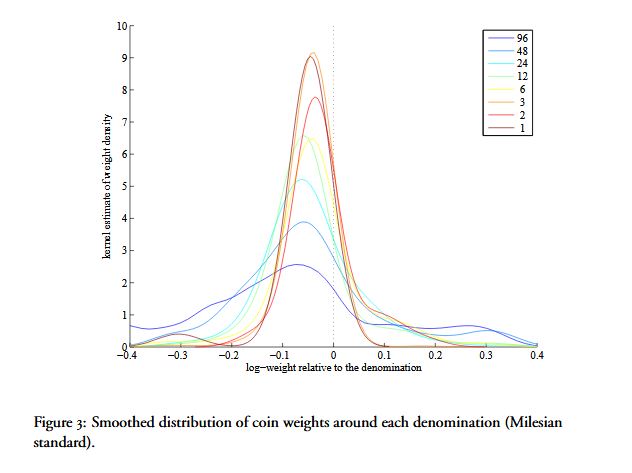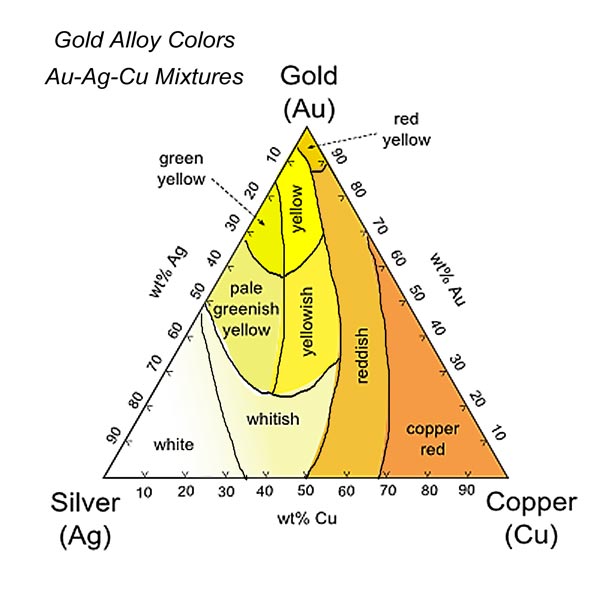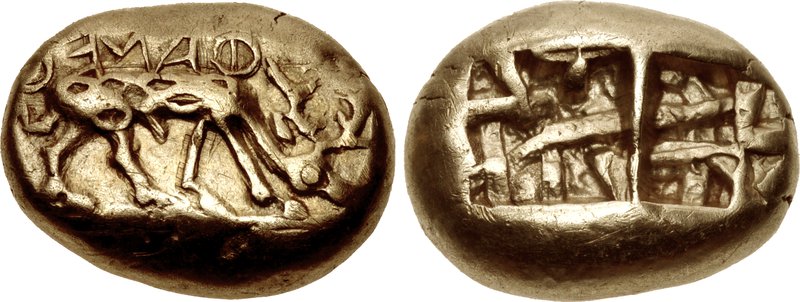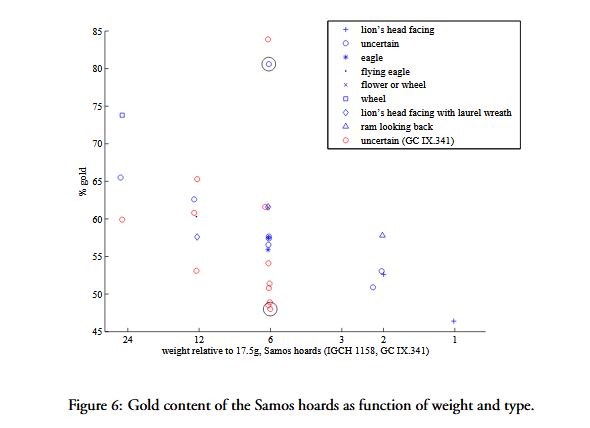The Puzzle of Electrum Coins
For several years Brits have been hearing rumours that their 1p and 2p coins were on the cusp of being discontinued. Not so. Last month the UK Treasury announced its commitment to both coins. The 1 and 2p coins will continue to be produced for ‘years to come.’
Few bits of monetary technology have enjoyed as long an existence as the coin. The earliest coins were produced around 640 BC, some 2600 years ago, by the Lydians, who had built an empire in the western half of what is now Turkey.
To most of us, the usefulness of coins is self-evident. Sure, small coins like the 1p are a bit of a nuisance. They tend to accumulate in our pockets or piggy banks, never used. But compared to barter, or exchanging bits of unrefined metal, coins are a much better alternative.
One would assume that’s why the Lydians created coins in the first place: convenience. But the true story is much more puzzling than that. To this day we don’t entirely know why the Lydians began to turn precious metals into circular discs.
The Traditional origin story for Coins
The classic story for the adoption of coinage involves the efficiency gains that society enjoys when trade can be conducted by tale rather than by weight. Tale is a sum or a tally. All modern payments are done by tale. A payor counts up the right amount of coins (or notes), then passes the stack to the payee who – if they wish – can glance at the inscription on each coin’s face to ensure that it is legitimate. Circulation by tale is a convenient way of doing business.
But we take it for granted. Before coins appeared on the scene 2000 years ago, numismatists believe that people typically transacted with silver ingots and bars, otherwise known as hacksilber. These pieces could be cut up into smaller amounts in order to cover a range of different transaction sizes.
Because the bits of hacksilber were irregularly shaped, or non-fungible, they couldn’t by counted. Rather, they had to be weighed first, and only then could the transaction proceed. Weighing different bits of silver is a laborious process. A scale must be produced along with a set of weights that both the buyer and seller can trust.
Counting is much easier than weighing. If the stamp on the coin is reliable, buyers and sellers can trust to issuer to have already pre-weighed and standardized the metal for them. And so coinage would have dramatically reduced lineups and waiting time in busy markets all across the ancient world. What a fantastic invention.
Perfectly Standardized
At first glance, Lydian coins have all the hallmarks of this classical origin story.
To begin with, they are quite beautiful. Each coin was typically stamped on the obverse side with a design in the form of an animal, human, or myth. On the reverse, or back-side of the coin, a square or rectangular design appears. Did these designs constitute some sort of official guarantee of the coin’s weight and fineness? Or did they symbolize something else?

The coins generally lacked any sort of writing on them. Numismatists are thus unsure who actually issued the coins. Was it the city, the king, a merchant or some other rich individual?
One fact that all numismatists agree on is that the Lydians were assiduous to a fault about ensuring standardized weights for their coins. The biggest denomination, the stater, weighed 14.1 – 14.3 grams. Half staters contained half as much metal, followed by third staters (or trites), 1/6, 1/12, 1/24, 1/48, and 1/96th staters, the last of which contain just 0.15 grams of metal.

Francois Velde, an economist at the Federal Reserve who dabbles in numismatics, has catalogued thousands of Lydian coins owned by private collectors and museums around the world. Using this data, one can see the remarkable precision of Lydian coinage (see chart above). The weight of the largest coins – staters and trites – tend to be tightly clumped near the standard weight.
Interestingly, the smallest denominations – the 1/96th staters – are much more loosely distributed around the standard weight (see the dark blue line). Velde (2012) attributes some of the lower accuracy of smaller denominations to the fact that they would have circulated more, and thus deteriorated faster.
The inconvenience of Electrum
By carefully calibrating the weights of each denomination and stamping them with a seal, surely Lydia qualifies as the first society to make the technological leap to circulation by tale. But it’s here that the story begins to fall apart.
One of the curious facts of early Lydian coins is that they were made from a material called electrum. Electrum is a naturally occurring alloy of silver and gold, often found in streams and rivers. The problem with natural electrum is that the mix between gold and silver is variable. The silver content can be anywhere from 10% to 30%, according to numismatist Robert Wallace (1987).
Given this variability, Lydians must have had difficulties valuing electrum. A given electrum coin wasn’t fungible, or interchangeable, with its cousins. A coin with more gold in it would have a slightly different colour than one with less gold, as the chart below implies. And since gold was probably worth around 10 times more than silver in ancient times, electrum coins with more gold in them would have had a much higher intrinsic value than those with less. But how much more? According to Wallace, this lack of certainty would have caused “endless doubts and disputes over particular coins."

What a contradiction Lydian coins are! The Lydians had evidently gone to extreme lengths to perfectly calibrate coin weights, and thus potentially exchange coins by tale, only to undo all the benefits of standardization by making coins with an arbitrary gold-silver mixture. Now buyers and sellers would have to settle on some laborious means of determining a given coin’s mixture, say like using a touchstone, before they could consummate a trade.
The Lydians could have avoided this problem at the outset by issuing coins using silver rather than electrum. Silver, after all, was already traded in ingot form. With silver coins, at least there would be no confusion about intrinsic value. But the Lydians chose not to go this route.
Which leads us to what may be the most popular theory for electrum coins, what I will call the “token" theory.
Electrum Coins as Tokens
It is Robert Wallace who can be credited with creating what is probably the most widely-accepted theory for electrum coins. Wallace (1987) began by imagining himself in the shoes of an owner of an electrum hoard around 640 BC. This individual had the following problem. His stash of metal was not uniform, and so fellow Lydians didn’t really trust its quality. How could our electrum owner get his suspicious counterparts to accept his metal for its full value?
The easiest solution available to our Lydian would be to refine his electrum into its silver and gold constituents, then sell each separately. But Wallace tells us that the technology for “parting" gold and silver – cementation – would not be available for almost a hundred years, circa 550 BC. So our electrum owner was stuck with his mongrel metal.
According to Wallace, our Lydian stumbled on the solution: turn his raw electrum into stamped coins. Why would a potential buyer trust electrum in coin form but not bar form? The answer is that the owner of electrum didn’t create just any regular coin. Rather than issuing discs that were valued for their (uncertain) metal content, our Lydian electrum owner designed them as tokens.

How did a mere stamp create value? Wallace hypothesizes that the issuer’s stamp indicated a promise to “accept back or redeem his coins" at a fixed rate. A skeptical buyer would therefore have no problem receiving an electrum token in trade. After all, the stamp guaranteed that the issuer would buy it back at that very same rate.
Fungibility Regained
By setting his redemption price for tokens high enough, the issuer ensured that the market value of his coins would always exceed their intrinsic electrum value. This would have had the beneficial effect of making all his electrum coins fungible. After all, since both a silver-rich electrum token and a gold-rich one could both be redeemed at the issuer for the same fixed price, neither coin was any better than the other.
Electrum could now circulate freely rather than being handicapped by non-uniformity. The decision to turn electrum into coinage had converted “stocks of what was otherwise a doubtful and uncertain substance into negotiable currency large and fixed value," says Wallace. In the process, our electrum owner had become a much wealthier man than might otherwise have been the case.
So what about Circulation by Tale?
Despite the fact that the weight of electrum coins was so precisely calibrated, numismatists believe that Lydians exchanged the coins by weight rather than by tale, much as they had with hacksilber. The main bit of evidence for this is that electrum coins were never clipped.
Clipping is when someone scrapes or snips a bit of metal off of a coin before passing it on. The clipper keeps the shavings for themselves. Coins that circulate by tale are easily attacked by clippers. Since sellers will accept coins with little more than a glance to the stamp on the coin’s face, a buyer who scrapes off a bit of metal before handing the coin can easily get away with it.
A lack of clipping is consistent with the practice of weighing coins and only accepting those that are up to snuff. If a coin was even a bit too light, then the seller would not take it. And so no one would bother clipping them in the first place.
But if electrum coins circulated by weight and not tale, this hardly seem like a technological improvement over hacksilber. Lydian trade was still as slow and awkward as before.
However, the necessity of weighing electrum coins may have served a purpose. It may have been a security feature designed to protect the issuer’s wealth. Imagine that our issuer of electrum tokens has spent some staters into circulation. Prior to being returned to him for redemption, these staters had all been clipped. Since he has less electrum than what he started out with, our issuer’s wealth has deteriorated.
To protect himself from this sort of theft, Wallace (1989) suggests that the issuer wouldn’t redeem just any of his tokens. As a security measure, he would only take back those that were still of their original weight. Since no merchant would want to be stuck holding a coin that could not be redeemed, they would always weigh each coin that was offered to them in order to avoid accepting light ones.
They only circulated domestically
Wallace’s theory explains another odd feature of electrum coins. Given the distribution of electrum coin hoards, numismatists believe that they didn’t circulate outside of their area of production. This is unusual for ancient coinage. Roman coins have been found as far afield as Sumatra, while Sasanian coins (minted in modern day Iran) circulated in England.
But if circulation of electrum coins was premised on the guarantee that their issuer would redeem them, then that explains why they wouldn’t have circulated very far. People in a distant city would not recognize or trust the redemption promise of an unknown issuer, and so they wouldn’t accept them in trade.
Electrum diluted with Silver
Another oddity of electrum coins is that they often contain far more silver than the natural electrum out of which they were manufactured. Electrum found in naturally-occurring deposits usually contains no less than 70% gold, but the coins themselves often contain just 45-55% gold. For some reason, Lydians coin issuers chose to introduce a bit of pure silver into the electrum mix before coining it.
In the chart below, for instance, the vertical column that represents the 1/6 stater denomination contains around 14 different coins. The majority of these coins contain less than 65% gold. Only two contain more than 80% gold.

Why would the Lydians have chosen to dilute electrum with silver? The intrinsic value of natural electrum was quite high. Given that gold was worth around ten times the value of silver, numismatists estimate that the most commonly available coin, the trite, was worth several sheep, or ten day’s wages (de Callatay, 2013). Converting into modern terms, the trite would be worth the equivalent of a $500 bill. This hardly seems a very convenient denomination. The smallest coin, the 1/96th stater, was worth about a day’s wages, and thus not useful as small change (Velde, 2012).
Wallace (1987) suggest that by mixing some silver into the natural electrum, the intrinsic value of the coin would have been reduced. The price at which the issuer promised to redeem the coin could now be lowered. This reduction would have permitted electrum coins to participate in a wider range of transactions, thus increasing their usefulness.
Still more Questions
New data and theories about electrum coins have improved our knowledge. Unfortunately, it seems that we remain “confused but on a higher level!" remarks historian Francois de Callatay (2013). While Wallace’s theory is elegant, it leads to only to more questions.
Velde asks a few of the more glaring ones. If electrum coins were redeemable, what did the issuer promise to redeem their coins with? Gold? Silver? Perhaps they be used to discharge taxes? If gold and silver were to be used to redeem electrum coins, why not use these materials as the basis of coinage instead?
And what did the issuer keep in reserve to “back" his guarantee, wonders Velde. If each coin had to be 100% backed by gold, then our issuer would have had to incur the costs of storing and vaulting the yellow metal. This would have meant that issuing coins wasn’t very profitable. One wonders why our electrum owner would have bothered producing them in the first place.
Electrum Coins, What happened to them?
Whereas the Brits still seem to be quite fond of their 1p and 2p coins, the Lydians quickly discontinued their electrum coinage. About a hundred years after electrum coins were first issued, they disappear from the numismatic record.
Around 550 BC, King Croesus decided to issue individual silver and gold coins. This switch from electrum to pure gold and silver coincides with the discovery of the process of cementation, the ability to separate gold from silver. Presumably decomposing electrum into its constituent parts in order to create a uniform currency was deemed superior to issuing electrum discs.
Except for a few smaller city-states that continued to issue electrum coins for another century or two, never again would a mixed silver-gold coin be issued. All that remains is a mystery for modern numismatists to puzzle over.
Sources:
- de Callatay, Francois. White Gold: An Enigmatic Start to Greek Coinage. 2013. [Link]
- Velde, Francois. On the Origin of Specie. 2012. [Link]
- Velde, Francois. A Quantitative Approach to the Beginnings of Coinage. [Link]
- Wallace, Robert. The Origin of Electrum Coinage. 1987. [Link]
- Wallace, Robert. On the Production and Exchange of Early Anatolian Electrum Coinage. 1989. [Link]
Popular Blog Posts by JP Koning
 How Mints Will Be Affected by Surging Bullion Coin Demand
How Mints Will Be Affected by Surging Bullion Coin Demand
 Banknotes and Coronavirus
Banknotes and Coronavirus
 Gold Confiscation – Can It Happen Again?
Gold Confiscation – Can It Happen Again?
 Eight Centuries of Interest Rates
Eight Centuries of Interest Rates
 The Shrinking Window For Anonymous Exchange
The Shrinking Window For Anonymous Exchange
 A New Era of Digital Gold Payment Systems?
A New Era of Digital Gold Payment Systems?
 Life Under a Gold Standard
Life Under a Gold Standard
 Why Are Gold & Bonds Rising Together?
Why Are Gold & Bonds Rising Together?
 Does Anyone Use the IMF’s SDR?
Does Anyone Use the IMF’s SDR?
 HyperBitcoinization
HyperBitcoinization






 JP Koning
JP Koning 0 Comments
0 Comments










